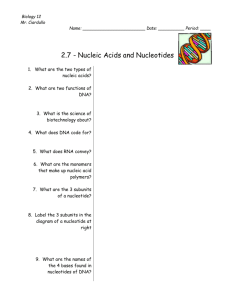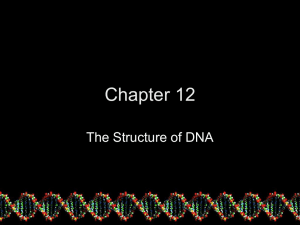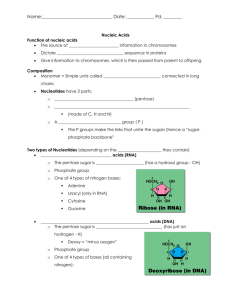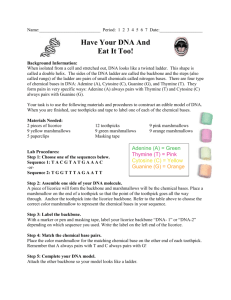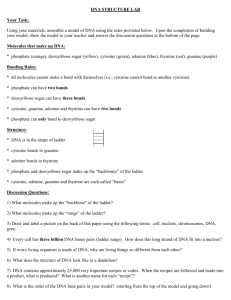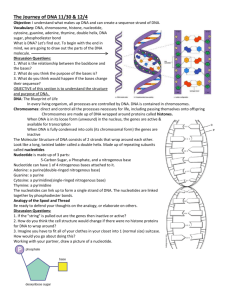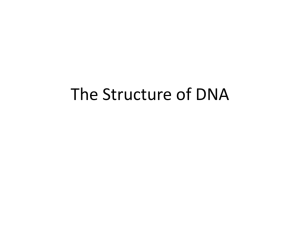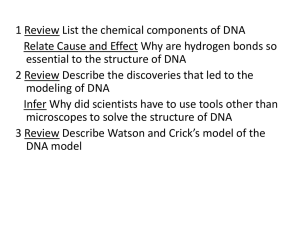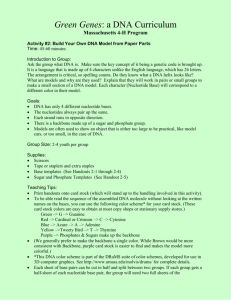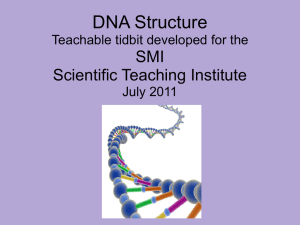DNA and its Structure
advertisement
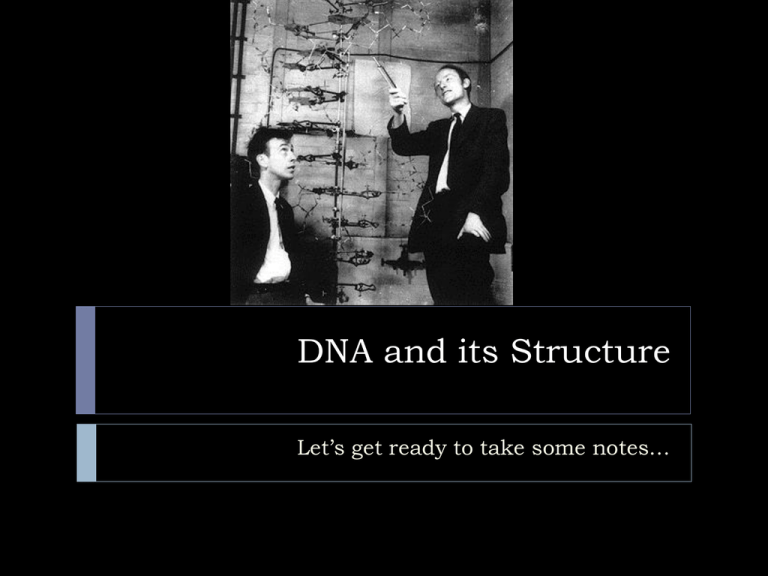
DNA and its Structure Let’s get ready to take some notes… DNA Deoxyribonucleic Acid Determines an organism’s traits by determining the structure of proteins Background 1950’s: many scientists believed that proteins were the genetic material 1952: Alfred Hershey and Martha Chase Their experiment determined that DNA is the genetic material Video clip Background continued 1953: Watson and Crick proposed that DNA is made of two chains of nucleotides held together by hydrogens bonds between the nitrogenous bases They also said that DNA is shaped like a twisted ladder, or double helix The Structure of Nucleotides DNA is a polymer made of repeating subunits, or monomers, called nucleotides Nucleotides are made of three parts. 5 Carbon sugar Deoxyribose Phosphate group Nitrogenous base Phosphate Sugar Nitrogenous Base Nitrogenous Base Carbon ring structure 4 types Adenine purines Guanine Cytosine Thymine pyrimidines Therefore There are four possible nucleotides because there are four nitrogenous bases Nucleotides bond together by the phosphate of one to the sugar of the next Adenine only bonds with Thymine Held together by two hydrogen bonds Thymine Adenine Guanine only bonds with Cytosine Held together by three hydrogen bonds Cytosine Guanine The importance of nucleotide sequence All organisms have DNA made of the same four nucleotides The differences in organisms is because of the difference in the sequence of nucleotides Chagraff’s Rule Adenine will always pair with Thymine Guanine will always pair with cytosine Fact Check Let’s get our boards ready… Who established the structure of DNA? a) Darwin and Virchow b) Watson and Crick c) Hooke and Schwann d) Rutherford and Millikan The structure of DNA is a) A square b) A pentagon c) A helix d) A double helix How many hydrogen bonds hold guanine to cytosine? a) One b) Two c) Three DNA was established as the genetic material because a) Radioactive sulfur was found inside cells infected by bacteriophages b) Radioactive phosphorous was found inside cells infected by bacteriophages The sugar in DNA is called a) Sucrose b) Ribose c) Lactose d) Deoxyribose How many hydrogen bonds hold adenine to thymine? a) One b) Two c) Three A, C, G, and T Helium b) Hydrogen c) Oxygen d) Nitrogen a) are ______ bases Adenine pairs up with cytosine. True or false Guanine pairs up with cytosine. True or false In the picture of a DNA backbone on the right, the pentagons represent ___ and the circles represent ___. a) Deoxyribose, phosphate b) Phosphate, deoxyribose Adenine pairs up with thymine. True or false The DNA strand that would pair with the strand on the right would read (from top to bottom) a) GAC b) CTG c) TCG d) ACT Snake DNA and human DNA consist of the same four nucleotides, just in different sequences. True or false DNA is double-stranded. True or false DNA is a monomer. True or false What kind of bond holds together the sides of the DNA double helix? a) Hydrogen b) Covalent c) Ionic DNA is a macromolecule. The subunits that make it up are called a) Monosaccharides b) Fatty acids c) Amino acids d) Nucleotides Each a) b) c) d) nucleotide consists of A phosphate group A sugar A nitrogen base All of the above The a) b) c) d) purines are Adenine and thymine Thymine and cytosine Cytosine and guanine Guanine and adenine The a) b) c) d) pyrimidines are Adenine and thymine Thymine and cytosine Cytosine and guanine Guanine and adenine
